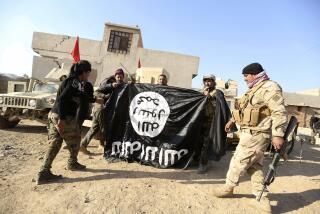Editorial: Islamic State’s disgraceful effort to raze history

U.S. Army soldiers tour St. Elijah monastery on the outskirts of Mosul, Iraq, in 2008. St. Elijah joins a growing list of more than 100 religious and historic sites demolished by the Islamic State militant group.
- Share via
Islamic State abducts, rapes and enslaves women. It massacres Christians and Yazidis. It beheads hostages and puts homosexuals to death. It organizes terrorist operations against civilians in cities like Paris, and its followers continue the work in San Bernardino and elsewhere.
Given such unfathomable and appalling crimes, it is sometimes difficult to explain why the world should be particularly distressed by the group’s wanton destruction of monuments, holy sites and antiquities. These are, after all, just structures of brick, stone and mud, just physical representations of human culture. A single life is worth more than the oldest temple, by most people’s estimates.
Nevertheless, the news this week that the 1,400-year-old St. Elijah monastery — also known as Dair Mar Elia — just south of Mosul, Iraq, was razed by Islamic State can’t help but cause anguish and outrage.
The group has not taken credit for the demolition of the 6th century monastery, but satellite photos tell the story. And of course such an act is entirely in line with Islamic State’s determination to wipe the region free of Christian and other “idolatrous” cultures that it believes are contrary to its “pure” interpretation of Islam. The group blew up the 2,000-year-old Temple of Baalshamin in the ancient city of Palmyra, Syria, as well as the mosque of the prophet Yunus in Mosul, and it has damaged or destroyed dozens of other tombs, churches, mosques and shrines in ancient communities like Nineveh and Nimrud using explosives and bulldozers. Libraries and museums have been pillaged of art and manuscripts, and subsequently ruined by rampaging Islamic State fighters wielding pickaxes and sledgehammers.
It goes without saying that the damage to the monastery in Mosul, to the temples in Palmyra and to other ancient structures must be measured against the unspeakable human devastation Islamic State has left in its wake, including thousands of civilian victims, mostly Muslims. But the buildings and manuscripts and works of art matter too. They are, after all, tangible records of humanity’s ambitions, achievements and values, physical representations of how far society has come — or failed to come — in recent centuries, of who we were and who we are now. Islamic State’s efforts to erase the historical record go hand in hand with its efforts to erase the people with whom it disagrees.
In the end, the solution to both problems is the same. President Obama is right when he says that Islamic State is unique in its brutality and that the world must unite to “degrade and ultimately destroy” it.
Follow the Opinion section on Twitter @latimesopinion and Facebook.
More to Read
A cure for the common opinion
Get thought-provoking perspectives with our weekly newsletter.
You may occasionally receive promotional content from the Los Angeles Times.










